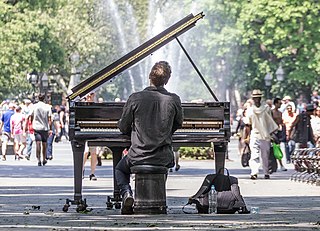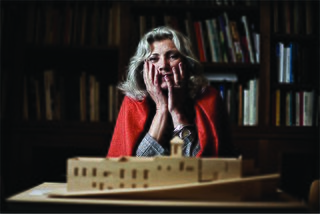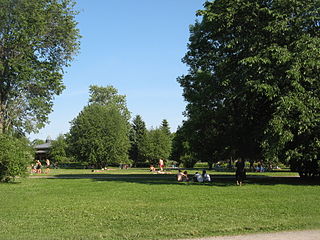
Jane Jacobs was an American-Canadian journalist, author, theorist, and activist who influenced urban studies, sociology, and economics. Her book The Death and Life of Great American Cities (1961) argued that "urban renewal" and "slum clearance" did not respect the needs of city-dwellers.

Tàrrega is a town and municipality located in the Urgell comarca, Province of Lleida, Catalonia. According to the 2020 census, the town has a population of 17,445.

Urban ecology is the scientific study of the relation of living organisms with each other and their surroundings in an urban environment. An urban environment refers to environments dominated by high-density residential and commercial buildings, paved surfaces, and other urban-related factors that create a unique landscape. The goal of urban ecology is to achieve a balance between human culture and the natural environment.

Enric Miralles Moya was a Spanish architect from Barcelona, Catalonia. He graduated from the Barcelona School of Architecture (ETSAB) at the Universitat Politècnica de Catalunya (UPC) in 1978. After establishing his reputation with a number of collaborations with his first wife Carme Pinós, the couple separated in 1991. Miralles later married fellow architect Benedetta Tagliabue, and the two practiced together as EMBT Architects. Miralles' magnum opus and his largest project, the new Scottish Parliament Building, was unfinished at the time of his death.

The Death and Life of Great American Cities is a 1961 book by writer and activist Jane Jacobs. The book is a critique of 1950s urban planning policy, which it holds responsible for the decline of many city neighborhoods in the United States. The book is Jacobs' best-known and most influential work.

Mixed use is a type of urban development, urban design, urban planning and/or a zoning classification that blends multiple uses, such as residential, commercial, cultural, institutional, or entertainment, into one space, where those functions are to some degree physically and functionally integrated, and that provides pedestrian connections. Mixed-use development may be applied to a single building, a block or neighborhood, or in zoning policy across an entire city or other administrative unit. These projects may be completed by a private developer, (quasi-) governmental agency, or a combination thereof. A mixed-use development may be a new construction, reuse of an existing building or brownfield site, or a combination.

Placemaking is a multi-faceted approach to the planning, design and management of public spaces. Placemaking capitalizes on a local community's assets, inspiration, and potential, with the intention of creating public spaces that improve urban vitality and promote people's health, happiness, and well-being. It is political due to the nature of place identity. Placemaking is both a process and a philosophy that makes use of urban design principles. It can be either official and government led, or community driven grassroots tactical urbanism, such as extending sidewalks with chalk, paint, and planters, or open streets events such as Bogotá, Colombia's Ciclovía. Good placemaking makes use of underutilized space to enhance the urban experience at the pedestrian scale to build habits of locals.

Carme Pinós Desplat is a Spanish architect.

Cheirolepidiaceae is an extinct family of conifers. They first appeared in the Triassic, and were widespread during most of the Mesozoic era. They are united by the possession of a distinctive pollen type assigned to the form genus Classopollis. The name Frenelopsidaceae or "frenelopsids" has been used for a group of Cheirolepidiaceae with jointed stems, thick internode cuticles, sheathing leaf bases and reduced free leaf tips. The leaf morphology has been noted as being similar to that of halophyte Salicornia. Several members of the family appear to have been adapted for semi-arid and coastal settings, with a high tolerance of saline conditions. Cheirolepidiaceae disappeared from most regions of the world during the Cenomanian-Turonian stages of the Late Cretaceous, but reappeared in South America during the Maastrichtian, the final stage of the Cretaceous, increasing in abundance after the K-Pg extinction and being a prominent part of the regional flora during the Paleocene, before going extinct.

In urban planning, walkability is the accessibility of amenities by foot. It is based on the idea that urban spaces should be more than just transport corridors designed for maximum vehicle throughput. Instead, it should be relatively complete livable spaces that serve a variety of uses, users, and transportation modes and reduce the need for cars for travel.

In land-use planning, urban green space is open-space areas reserved for parks and other "green spaces", including plant life, water features - also referred to as blue spaces - and other kinds of natural environment. Most urban open spaces are green spaces, but occasionally include other kinds of open areas. The landscape of urban open spaces can range from playing fields to highly maintained environments to relatively natural landscapes.

Active mobility, soft mobility, active travel, active transport or active transportation is the transport of people or goods, through non-motorized means, based around human physical activity. The best-known forms of active mobility are walking and cycling, though other modes include running, rowing, skateboarding, kick scooters and roller skates. Due to its prevalence, cycling is sometimes considered separately from the other forms of active mobility.

Styporaphidia is a genus of snakefly, belonging to the extinct family Mesoraphidiidae, containing up to three species, the type species Styporaphidia magia, Styporaphidia willmanni and tentatively Styporaphidia? hispanica. The genus was named from the Greek stypos meaning "stem" or "stump" and Raphidia, the type genus for, and most often used as, a stem for generic names in the order Raphidioptera. The species name of S. magia is from the Greek word mageia meaning "magic" while the species name for S.? hispanica is from the Latin Hispania meaning "Spain" in reference to the type locality of the species.

Mandarin Oriental, Barcelona is a hotel located on Passeig de Gràcia in Barcelona, Spain. It opened in November 2009 and was designed in part by Spanish architects Carlos Ferrater and Joan Trias de Bes, and interior designer Patricia Urquiola. The hotel is housed in a mid-20th Century building. Mandarin Oriental, Barcelona also includes The Spa at Mandarin Oriental, Barcelona and five restaurants and bars, including Moments, a Catalan restaurant headed up by Carme Ruscalleda, a Michelin-starred chef.

Cantabroraphidia is an extinct genus of snakefly in the family Mesoraphidiidae. The genus is solely known from fossil amber found in Cantabria, northern Spain, dating to the Albian age of the Early Cretaceous Period. Currently the genus comprises a single species Cantabroraphidia marcanoi.

The architecture of Barcelona has undergone a parallel evolution alongside Catalan and Spanish architecture, reflecting the diverse trends found in the history of Western architecture. Throughout its historical development, Barcelona has been influenced by numerous cultures and civilizations, each contributing their artistic concepts and leaving a lasting legacy. The city's architectural heritage can be traced back to its earliest inhabitants, the Iberian settlers, followed by the Romans, Visigoths, and a brief Islamic period. In the Middle Ages, Catalan art, language, and culture flourished, with the Romanesque and Gothic periods particularly fostering artistic growth in the region.

Zhangsolvidae is an extinct family of brachyceran flies known from the Cretaceous period. Members of the family possess a long proboscis, varying in length between 1.3 and 7 mm depending on the species, and were probably nectarivores. A specimen has been found with preserved Bennettitales pollen, suggesting that they acted as pollinators for extinct gymnosperms. They are considered to be members of the Stratiomyomorpha.

The 4F case concerns the events of 4 February 2006 in Barcelona, in which a policeman patrolling outside a rave was paralyzed after being hit by a falling object and nine people were arrested in consequence. At a trial two years later, seven people were convicted, one of whom was then pardoned. On appeal to the Supreme Court, the sentences were lengthened and one person committed suicide.

The 1870 Barcelona yellow fever epidemic was an epidemic that took place in the Spanish city of Barcelona in 1870.

The urban planning of Barcelona developed in accordance with the historical and territorial changes of the city, and in line with other defining factors of public space, such as architecture, urban infrastructure and the adaptation and maintenance of natural spaces, parks and gardens.




















